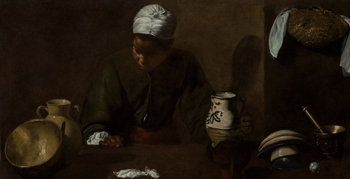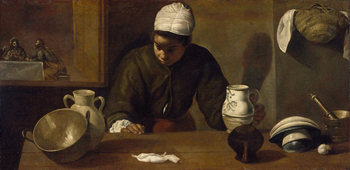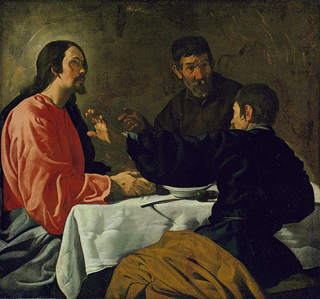From Our Archives
For another essay on this week's texts, see Debie Thomas, But We Had Hoped (2020).
For Sunday April 23, 2023
Lectionary Readings (Revised Common Lectionary, Year A)
Acts 2:14a, 36–41
Psalm 116:1–4, 12–19
1 Peter 1:17–23
Luke 24:13–35
This Week's Essay
We're now two weeks out from Easter, and in the reading from Luke 24 still dealing with doubts about the resurrection of Jesus.
Cleopas and his companion spent most of the day walking to Emmaus with Jesus, but they still didn't recognize the risen Lord. Later, when they told "the Eleven" leaders in Jerusalem what they had experienced, they disbelieved their report and were still doubtful. And when the resurrected Christ stood in their midst, writes Luke, "they still did not believe it."
All this disbelief has the ring of truth, in the sense of what's called a "contronym." A contronym is a single word that can have contradictory or opposite meanings. For example, to "consult" can mean either to give or to receive advice. In the case of the disciples, they couldn't believe that the resurrection stories were true, and yet they were likewise astonished at what they increasingly couldn't deny. Their "disbelief" cut both ways at the same time. We've all had similar moments of such incredulity — "I can't believe it!"
And let's remember, as Mary Gordon reminds us in her book Reading Jesus, we're not dealing here with any old story, with Oedipus, Lear, or Alexander the Great. Rather, we're interpreting a story that "either has no meaning or creates a meaning unique in the history of the world." Jesus is what she calls the "irresistible incomprehensible."
The poet John Betjeman (1906–1984) called it "the most tremendous tale of all," that "God was man in Palestine // And lives today in Bread and Wine." For C.S. Lewis the resurrection was the "deeper magic before the dawn of time." Rowan Williams, former Archbishop of Canterbury, appealed to science. At Easter, he says, "we are really standing in the middle of a second 'Big Bang,' a tumultuous surge of divine energy as fiery and intense as the very beginning of the universe."
 |
|
The Kitchen Maid by Velázquez, the Art Institute of Chicago.
|
Thanks to two paintings by Diego Rodríguez de Silva y Velázquez (1599–1660), and a poem about his paintings by Denise Levertov (1923–1997), we can relive the numinous shock of an ordinary person when she realized that the rumors of resurrection were true. There's a movement here in grappling with the resurrection — from prose narrative, to poetry, to images, and, finally, to sound — to the revelatory power of a familiar voice.
By the time that Cleopas and his unnamed companion had walked with Jesus the seven miles from Jerusalem to Emmaus, the evening darkness had descended upon them. When Jesus acted as if he would continue walking, they implored him, "stay with us, for the day is almost over." And so they had dinner at Emmaus.
During the day the men hadn't recognized the resurrected Jesus, but at dinner "their eyes were opened" and they understood what had happened. They immediately returned to Jerusalem and told "how Jesus was recognized by them when he broke the bread. It is true! The Lord has risen!"
Unless we believe that the men cooked their own meal and served themselves, there had to have been a woman behind the scenes for this dinner at Emmaus. But Luke leaves her unnamed and unmentioned. She is lost to history. And herein lies the genius of Velázquez and Levertov — their artistic fictions imagine a historical reality.
Velázquez actually painted two versions of the "Kitchen Maid" (in Spanish, La mulata, La cocinera, or Escena de cocina). It's the earliest known work by him, painted when he was about eighteen.
The copy in the Art Institute of Chicago shows only a mixed race maid. And for many decades, the version in the National Gallery of Ireland in Dublin likewise showed only the servant girl. But when the Dublin painting was cleaned in 1933, it revealed Jesus and the two men in the distant background of the upper left corner. Clearly, the Dublin version was the dinner at Emmaus and not just some domestic scene.
The main figure and visual center point in both paintings is the kitchen maid in the foreground. Jesus and the men are relegated to a back room in the background. We see them only through a window-like opening. Velázquez depicts the maid as a mixed race girl, the offspring of a Spanish Christian and an African Muslim.
Barry Wind observes that the Hispanic antipathy of that day toward Moors considered them "lazy, lubricious, and figuratively subhuman.” The subject of this painting, then, is a young woman who is marginalized at every level — by her mixed race, religion, gender, and class. While the men speak of spiritual matters in the back, she's hard at work in the kitchen preparing dinner for them.
 |
|
The Kitchen Maid by Velázquez, the National Gallery of Ireland.
|
The maid is visibly distracted. In her left hand she holds a ceramic jug of wine. She's glancing over her right shoulder, clearly eavesdropping on the back room conversation. She bends over to support herself. The stunned expression on her face indicates that her eavesdropping has confirmed her suspicion. She's in a state of disbelief at having recognized the man she's serving.
Whereas the men had been blind to the identity of Jesus even when he was with them for a seven-mile walk, the Moorish maid recognized the risen Christ while working in the mundane context of a kitchen. "God is found in the pots," said Teresa of Avila.
Denise Levertov's poem The Servant-Girl at Emmaus (A Painting by Velázquez) reimagines this revelatory moment. We know from a note of hers that she had seen the painting in Ireland. Her poem is what's called an ekphrasis — a literary description that illuminates a visual work of art. Levertov's poem is a meditation on Velázquez's painting.
She listens, listens, holding
her breath. Surely that voice
is his — the one who had looked at her, once, across the crowd,
as no one ever had looked?
Had seen her? Had spoken as if to her?
Surely those hands were his,
taking the platter of bread from hers just now?
Hands he'd laid on the dying and made them well?Surely that face — ?
The man they'd crucified for sedition and blasphemy.
The man whose body disappeared from its tomb.
The man it was rumored now some women had seen this morning, alive?
Those who had brought this stranger home to their table
don't recognize yet with whom they sit.
But she in the kitchen, absently touching the wine jug she's to take in,
a young Black servant intently listening,
swings round and sees
the light around him
and is sure.
Like Velázquez's painting, Levertov's poem focuses not on Jesus or his companions but on the maid. She's having an interior conversation with herself.
As she listens to the men in the back room, she realizes that she's encountered Jesus before. At first it's his voice, then his gaze, his healing hands that now took the bread from her, and finally his face. The repetition of "surely" three times indicates her shocking realization that this is Jesus risen from the dead, just like the rumors swirling around the villages had claimed.
 |
|
The Supper at Emmaus by Velázquez, the Metropolitan Museum of Art in New York.
|
Luke's story is clearly a eucharistic text. Luke 24:30 says that Jesus "took bread, gave thanks, broke it, and began to give it to them." These words are verbatim identical to all three accounts of the Last Supper in the synoptic gospels. It was precisely when Jesus "broke the bread" that "their eyes were opened" (24:31), a detail that Luke repeats a second time: "Then the two told [the other disciples] what had happened on the way, and how Jesus was recognized by him when he broke the bread" (24:35).
There's a third painting by Velázquez called "The Supper at Emmaus," now in the Metropolitan Museum of Art in New York. It's very conventional. It depicts only Jesus, Cleopas, and his companion, at the eucharistic moment when they recognize the risen Lord in the breaking of the bread.
I prefer the Dublin and Chicago versions, and Levertov's poem about them. In them, the maid serves the bread, she doesn't take the bread. She's an observer and not a participant of the eucharist. She's a mixed race outsider rather than a Spanish insider.
But it was the men who didn't believe the resurrection report of the women, and who were blind to the Christ who was right in front of them all day, whereas in the artistic imaginations of Velázquez and Levertov, it was an ordinary and unknown kitchen maid who testified first to the resurrected Lord.
Note: The reference to Barry Wind is in "Denise Levertov’s Religious Ekphrasis" by Cristina Giorcelli of the University of Rome.
Weekly Prayer
Henry Vaughan (1621-1695)
Unfold! Unfold! Take in His light,
Who makes thy cares more short than night.
The joys which with His day-star rise
He deals to all but drowsy eyes;
And, what the men of this world miss
Some drops and dews of future bliss.Hark! How His winds have chang’d their note!
And with warm whispers call thee out;
The frosts are past, the storms are gone,
And backward life at last comes on.
The lofty groves in express joys
Reply unto the turtle’s voice;
And here in dust and dirt, O here
The lilies of His love appear!
Dan Clendenin: dan@journeywithjesus.net
Image credits: (1) Wikipedia.org; (2) The National Gallery of Ireland; and (3) The Metropolitan Museum of Art, New York.





